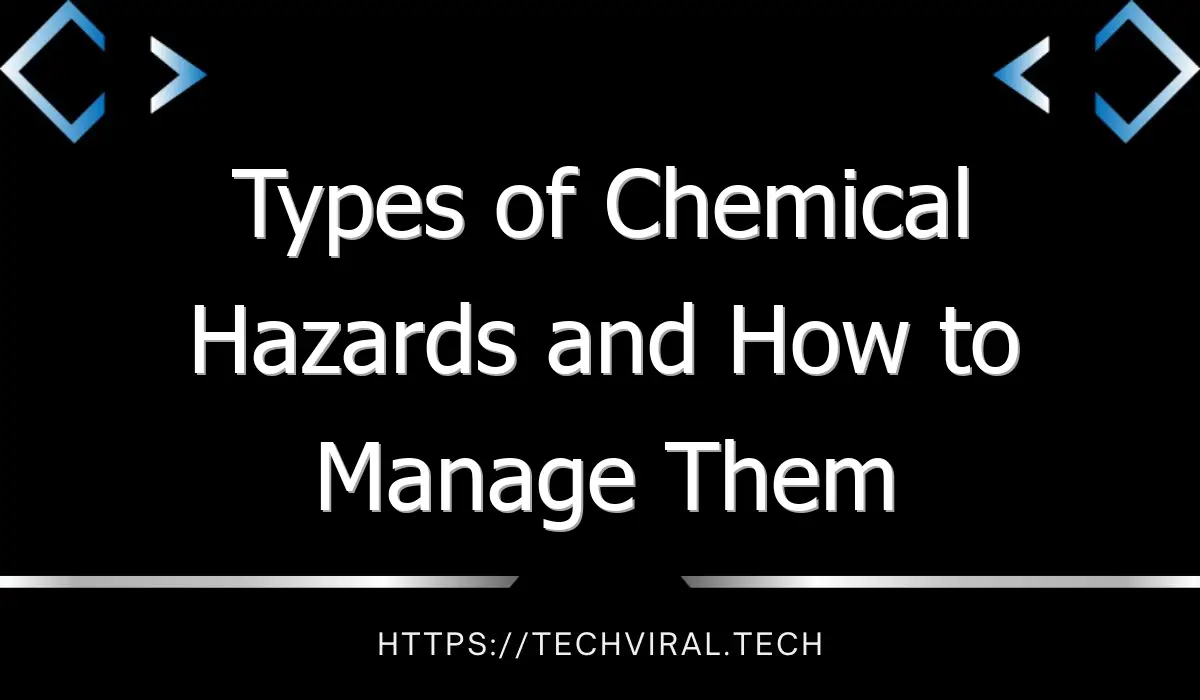Types of Chemical Hazards and How to Manage Them
There are several ways to manage or avoid chemical hazards in the workplace. The first step is to evaluate the risks and hazards associated with specific chemicals. This assessment should include the probability of the risks occurring and their severity. A comprehensive risk assessment will allow a business to prioritize the hazards and risks that must be addressed. The methods to eliminate or reduce the risks associated with chemicals include substitution, engineering controls, and administrative controls.
Processes for preventing chemical hazards
Processes for preventing chemical hazards are essential to the safety of any chemical production process. Hazardous chemicals can cause severe health and environmental damage if they are not handled properly. Chemical safety and risk assessment is an ongoing process that includes the design of a process’ containment, ventilation, and emergency procedures. Chemical safety and risk assessment takes several factors into account, including toxicity, reactivity, and flammability.
Chemical safety is crucial for the health of all workers, but it is also necessary to ensure the health of those around the chemicals. There are many processes and products that use chemicals, but improper use can lead to health risks and worker injury. To help prevent chemical hazards and prevent injury, proper safety training are essential.
When conducting experiments with hazardous chemicals, the proper execution of the experiments requires sound judgment, accurate risk assessment, and selection of appropriate work practices. These practices will protect the laboratory staff, the public, and the environment. Developing an effective chemical safety program will require a thorough understanding of PELs and TLVs. It will also require proper inventory management.
Processes for preventing chemical hazards include limiting exposure to hazardous chemicals, developing a central chemical register, and conducting consultations with employees. The process for reducing chemical hazards also includes replacing hazardous chemicals with safer alternatives. These alternatives may include latex paints, oil base paints, micro biology, and solvent recycling.
One of the best ways to reduce chemical hazards is to use engineering controls. Engineering controls help control the exposure of workers to hazardous chemicals. They can include mechanical ventilation systems and compliant chemical storage containers. They can also include automation of hazardous chemical processes. Administrative controls can also help reduce chemical risk. However, administrative controls do not control the source of the chemical hazard and rely on human behaviour and supervision.
Common workplace chemical hazards
In the workplace, workers are exposed to many chemical hazards. Many of these chemicals are harmful to health and can cause birth defects and serious respiratory problems. The effects of exposure to chemicals in the workplace can be immediate or delayed. Some of these chemical hazards can even be fatal. According to the Bureau of Labor Statistics, there were 297 deaths caused by chemical hazards between 2011 and 2017; nearly a third of these deaths were due to carbon monoxide inhalation. Besides death, workers also face serious injuries from exposure to these corrosive chemicals.
Fortunately, many of these workplace chemical hazards are preventable. To help keep employees safe, employers are required to provide Safety Data Sheets for all chemicals used in the workplace. They must also maintain a central register of these substances. In addition, GHS encourages employers to share their safety and health practices with employees.
Chemicals are used in many everyday products, and while they have many beneficial applications, they can also be dangerous when misused. Many employees have to deal with these chemicals on a regular basis at their jobs. For that reason, employers should train their employees about the proper handling and disposal of these substances. They should also have policies and procedures in place to help employees understand and follow the proper procedures.
OSHA has established a list of acceptable levels of hazardous chemicals for various industries. These levels are called PELs, and they are enforceable in most establishments that fall under their jurisdiction. The PELs are based on statutory requirements that consider risk and feasibility. They are not enforceable in establishments that are not in Cal/OSHA’s jurisdiction, but they can be helpful in ensuring workplace safety.
Cal/OSHA’s Hazard Communication Standard
A pictogram is a visual representation of a chemical hazard, which includes a symbol, background pattern, color, or combination thereof. The pictogram conveys specific information about the chemical’s properties, which may be life-threatening, and it identifies the recommended measures to prevent the adverse effects of exposure. There are eight pictograms designated under the standard, and each one is associated with a specific hazard category.
In California, the Hazard Communication Standard for chemical hazards requires employers to implement a program to provide workers with information about these chemicals. These programs should include labels, safety data sheets, and employee training. Hazardous chemicals include caustic, corrosive, flammable, and toxic chemicals that pose health and safety hazards. They are common in many industries and can cause severe injuries and illnesses if not properly handled and stored.
A written hazard communication program must include the identification of chemical hazards, SDSs, and workplace labeling systems. Additionally, workers must know how to identify and use personal protective equipment (PPE) and safety data sheets. Moreover, employees must be trained to identify and recognize hazardous chemicals, which can be detected through continuous monitoring, visual appearance, or employee-dedicated representatives.
A comprehensive hazard communication program should include training and hazard communication. This document can also serve as a training guide. Moreover, the document should be reviewed and updated at least once every year to reflect changes in the workplace. If you are unsure of the requirements, check out OSHA’s Hazard Communication webpage or the OSHA Fact Sheet for additional information.
The ACGIH is a nonprofit corporation with a mandate to provide guidelines and recommendations on occupational health hazards. It has established PELs, or Recommended Exposure Limits, for various chemical hazards. These PELs are used by the state to guide employers in evaluating the potential risks of exposure to hazardous chemicals.
Safety Data Sheets for chemicals
Safety Data Sheets (SDS) are documents that give details on the properties of a chemical and how it can affect human health and safety. They are also a helpful resource when a chemical is being used in the workplace. Among other things, these documents provide detailed information on the chemical’s physical, chemical, toxicological, and ecological hazards.
Safety Data Sheets, also known as Material Safety Data Sheets, are documents produced by manufacturers of chemical substances. These documents provide important information about the chemicals’ properties and hazards, and include instructions for safe handling. They also include information about storage, first aid, and spill/leak procedures. Safety Data Sheets are widely available on the Internet and can be used to make informed decisions when handling a particular chemical.
The purpose of Safety Data Sheets is to provide the public and employees with information on the hazards associated with chemicals. They are written by the manufacturer of the chemicals and include information about health hazards, physical properties, reactivity, toxicity, and exposure control. They also describe spill/leak procedures, and they are very useful in case of accidental spills. These documents also contain a product identifier and the name of the manufacturer or distributor.
Safety Data Sheets for chemicals are standardized documents that include information about the chemical products that are used in a workplace. They help users to evaluate risks and follow the right procedures to protect themselves from exposure. They provide detailed information on the chemicals’ hazards, proper handling, storage, and emergency measures. They are organized under 16 different headings to make it easier to access the relevant information.
Substituting hazardous materials
Substitution is the process of replacing hazardous materials in the workplace with safer alternatives. This can be done through a variety of means, including product redesigns, processes, and organisational changes. The benefits of substitution can be significant for a company, the environment, and the health of its workers. This process is one of the most effective ways to control chemical hazards in the workplace.
The substitution process takes into account legal restrictions and the level of exposure and hazard of the existing chemicals. It also considers the life cycle of the new substitute and its risk assessment. Using a SIN-list can help identify appropriate alternatives and the appropriate testing period. This is important for SMEs, which may not have the resources to conduct thorough risk assessment. In addition, the process can include the evaluation of new chemical solutions.
When substituting hazardous materials for chemicals that are not suitable for use in the workplace, it is important to evaluate the risks of each material before making the substitution. The SIN List and ChemSec databases contain information about the chemical’s risks and can help companies prioritize the candidates for substitution.
The OECD has published guidance on minimum requirements for assessing safe chemical alternatives. It explains how alternatives assessment works, how it should be conducted, and how to choose the appropriate methods and tools to conduct them. Other resources include the European Chemicals Agency, which offers information on the process, networks, and workshops.




